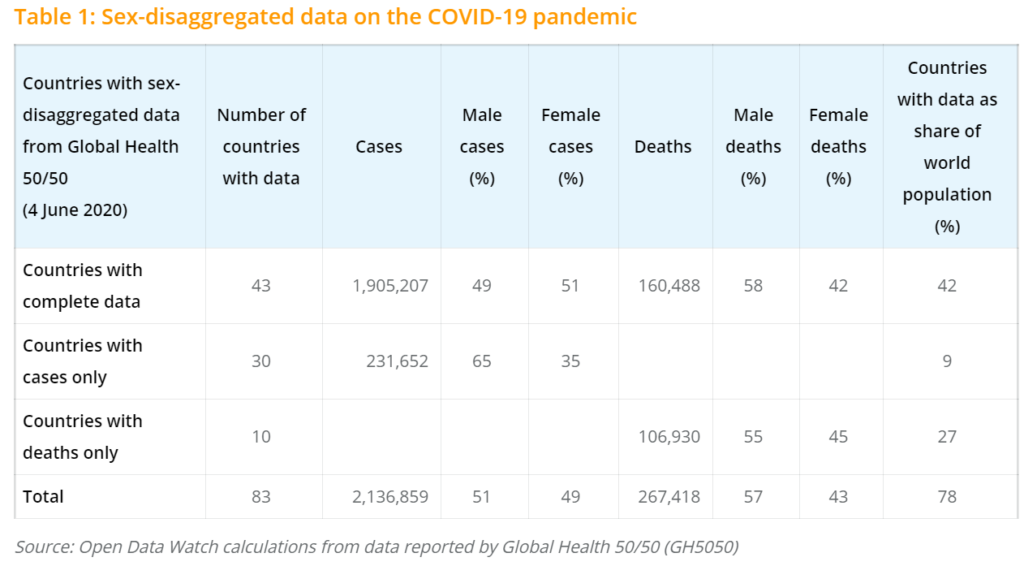This blog series is part of an ongoing study by Data2X and Open Data Watch to track the gender impacts of COVID-19. We recently published a report on the availability of sex-disaggregated data for tracking the primary and secondary impacts of the pandemic. Learn more in our summary blog post and full technical report, Tracking the Gender Impact of COVID-19: An Indicator Framework. This blog post originally appeared on Open Data Watch’s website.
We know that the COVID-19 pandemic is affecting men and women differently and may exacerbate gender inequalities, and we also know that gender roles will help shape adaptive responses to the pandemic.
Thanks to information available through volunteer efforts coordinated by Global Health 50/50, we are now closer to being able to analyze the impact of COVID-19 on men and women around the world.
In this first post of a blog series, we summarize the existing data from Global Health 50/50 and ask how complete our picture is when compared to all reported cases and deaths. Future iterations will examine the distribution of sex-disaggregated cases and deaths across other dimensions. These will include income and regional distributions of cases and deaths, discussions of differing estimates across sources, as well as evaluations of the availability and timeliness of complementary indicators to track the primary impacts of the pandemic, such as sex-disaggregated occupations and risk of exposure.

Table 1 summarizes the sex-disaggregated data available as of 4 June 2020. There were 43 countries reporting sex-disaggregated data for COVID-19 cases and deaths. (These include three nations of the United Kingdom – England, Scotland, and Northern Ireland – that are reported separately. Wales reports cases only.) They represented 42 percent of the world’s population (2019 data). Ten countries report sex-disaggregated data for deaths only. Thirty more countries report sex-disaggregated data on cases but lack data on deaths. For all countries reporting sex-disaggregated data, women make up 51 percent of cases but only 42 percent of deaths.
Although stories about reported cases and deaths caused by the COVID-19 virus have mainly covered high-income countries, information about the pandemic in low- and lower-middle-income countries is slowly emerging and will be crucial to monitoring the impacts of the pandemic on development efforts and the 2030 Agenda. As of 4 June 2020, three low-income countries, Somalia, Haiti, and Nepal published sex-disaggregated data on cases, while full, cases only, or deaths only sex disaggregation is available for 14 lower-middle-income countries.[1]
Table 2 summarizes the number of cases and deaths compiled by the European CDC and reported by Our World in Data (OWID) for the countries with sex-disaggregated data and for the remaining 131 countries that currently lack any sex-disaggregated data. (Figures in square brackets are for countries that report either cases or deaths but not both in GH5050. Data for the four nations of the United Kingdom are included in Table 2 as a single country reporting sex-disaggregated cases and deaths.)
The countries included in the GH5050 reports account for 86 percent of global cases and 96 percent of deaths. However, when accounting for countries publishing only case or death information, the shares drop to 42 percent and 95 percent, respectively.[2] This adjustment reveals that deaths are nearly all sex-disaggregated, though this may be skewed by most deaths occurring in high-income countries, which have more robust death registration systems. A future blog will explore the differences in coverage by income groups and regions. Meanwhile, only 2 in 5 cases is sex-disaggregated, a ratio that would double to 4 in 5 if Brazil and the United States reported their cases by sex.

Data around COVID-19 are abundant but still incomplete. In the flurry of information and debates over policies, the focus of this blog series will be to present weekly updates of the best sex-disaggregated information on the pandemic and to look at the data from a variety of perspectives.
